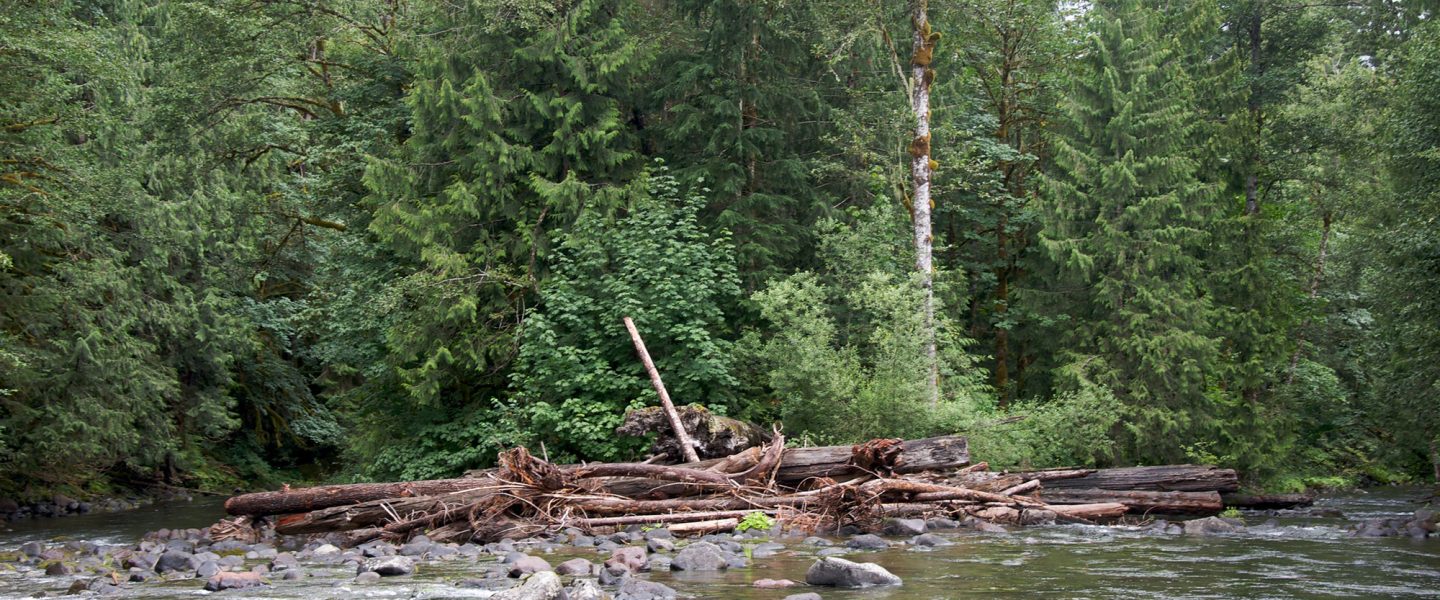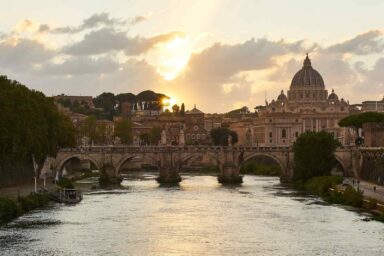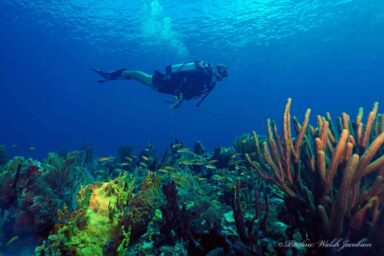An unconventional gathering helped spur ideas to speed the pace and scale of river restoration projects across the West.
|
Listen To This Story
|
Brian and Pat Robertson first noticed something wrong nearly 30 years ago. A stream called Little Bear Creek ran through their property in northern Idaho, but the waterway had long ago been altered during a logging operation and essentially functioned as a ditch, carrying water swiftly away from the valley. Trees were dying; the water table was dropping; neighbors were digging dry wells. After consulting with Natural Resources Conservation Service and touring several US Forest Service restoration projects in Oregon, the Robertsons decided to take the creek back to Stage Zero.
Stage Zero is like hitting the reset button to a time before the stream had formed a channel. With help from 10 agencies, the Robertsons filled in their stretch of Little Bear Creek until it was flush with the surrounding landscape. They scattered large logs about to help slow the flow of water. Then the stream could decide where it wanted to go: spreading out in fingers across a valley; pooling in wetlands; creating little micro-habitats — places where water-loving plants could grow, insects could hatch, and young salmon could thrive.
Since the restoration at Little Bear Creek began more than five years ago, the water table has risen several feet. The meadow is transforming into a wetland. In time, the Robertsons say, willows may return, then beavers.
The Robertsons’ project is an example of process-based restoration. This approach differs from conventional form-based restoration, which emphasizes building discreet structures and modifying a river channel. Process-based restoration is about restoring functions, and its scope expands beyond the channel to include the floodplain and valley bottom — the whole riverscape.
Chris Jordan, a fisheries biologist at the National Oceanic and Atmospheric Administration, was an early pioneer of process-based restoration. In 2009 he led an experiment sinking posts into a riverbed in central Oregon to give beavers points of attachment for their dams. The beavers responded. Four years later the water level had risen, and juvenile steelhead had increased by 175 percent. The processes set in motion not only improved the quality of the habitat, but the quantity, too.
Could the same thing happen elsewhere?
River systems across the West are degraded from logging and grazing, channelization, the removal of beavers, and the construction of dams, diversions, dikes, and roads. Twenty-eight species of salmon and steelhead are currently listed under the Endangered Species Act.
There’s a whole industry — Jordan calls it the restoration-industrial complex — focused on form-based restoration: building log jams, excavating river channels, and populating riverbanks with native plants.
“There’s billions of dollars being spent, yet on the salmon recovery side of things, we’re not seeing the ecological uplift of the projects,” he says. Notably, you do see those benefits with process-based restoration projects, which include such things as removing dams and breaching levees as well as newer strategies such as building beaver dam analogs. But they aren’t happening fast enough to address the crisis at hand.
“I think it’s crystal clear that everyone in the restoration community and people throughout government understand that we’re dealing with catastrophic species and habitat loss that’s only going to be exacerbated by climate change,” says Erika Lovejoy, director for Sustainable Conservation’s Accelerating Restoration Program. “If we don’t do the restoration more quickly and put these solutions in place, we’re going [to] end up dealing with everything on an emergency basis.”
An Unconventional Workshop
Jordan and his colleague at NOAA, Senior Policy Advisor Irma Lagomarsino, wanted to get more people on the process-based restoration bandwagon. Their solution: a special workshop called Restoring Riverscapes. The three-day event, held in March 2023, gathered students and scientists; fluvial geomorphologists, aquatic ecologists, and fish biologists; civil engineers and regulatory specialists; private landowners, tribal members, and ranchers — in the same virtual room.
“The workshop was designed to help the very large community in California, Oregon, Washington, and parts of Idaho to learn and think together about potential solutions or ideas to expand the rate and the pace and the scale of process-based habitat restoration,” says Lagomarsino.
Jordan and Lagomarsino didn’t want Restoring Riverscapes to be an ordinary workshop. They brought on a team of producers, led by filmmaker Sarah Koenigsberg, who, among other projects, produced the award-winning feature documentary The Beaver Believers.

Restoring Riverscapes took over a year to plan. Koenigsberg helped them shape the workshop experience like a story, with a clear narrative arc. They created a color-coded chart of the presentations: inspiring stories of stewardship interspersed with pre-recorded presentations and live panels — no snoozy PowerPoints. The planners knew they would have to appeal to people from career restoration practitioners to graduate students to decision-makers — many of whom aren’t scientists.
“We needed to change people’s minds,” says Jordan. “And you don’t change someone’s mind when they’re asleep.”
The first half of the workshop laid the foundation: explaining what process-based restoration is, why it works, and showcasing examples. A trio of career Forest Service biologists traced their long evolution as restoration practitioners who now embrace the concept. Lisa Huntington talked about restoring a creek and floodplain in a Portland neighborhood. A short film presented the Robertsons’ story.
With help from a team of filmmakers, editors, and other creatives, Koenigsberg produced this and three other films specifically for the workshop. The films are moving, the production values high. Storytelling is critical for winning hearts and minds, she says. “When you see other people who persevere and were inspired and didn’t give up, that’s what gives us this inspiration to go try, and to also keep at it.”
Cutting the Green Tape
Midday on day two, the focus pivoted to why it’s so hard to get more of this work done. Topping the list are regulatory compliance, landowner cooperation, and funding.
Restoration projects typically require a host of permits: water quality certification, removal-fill permits from the Army Corps of Engineers, floodplain development permits from the county, Endangered Species Act compliance…the list goes on. Whether seeking permission to build a beaver dam analog or a bridge, the regulatory requirements are the same, and they are costly and time-consuming.
“The systems that were created to protect the environment and stop bad things from happening were designed for development-type activities,” says Lovejoy. “They aren’t designed to help fix the environmental problems that we face in any type of efficient manner.”
Lovejoy is part of a coalition that successfully lobbied the state of California to create separate streamlined permitting pathways for restoration projects. Natural Resources Secretary Wade Crowfoot took up the cause, launching Cutting the Green Tape, an initiative to accelerate ecological restoration across the state.
Cal Trout is taking advantage of a new programmatic permit for its project on Big Chico Creek in Northern California, which aims to restore over eight miles of salmon and steelhead habitat. They estimate it will cut permitting time in half and slash costs by $250,000.

During her presentation, Lovejoy outlined the ingredients needed to catalyze such a sea change: strong coalitions, empowered agency staff, and support from leadership. She hopes other states, or maybe even the West as a whole, can develop similar initiatives to speed restoration efforts.
“When you have the permitting, the technical assistance, and the funding under one roof, I feel it helps change the mindset,” she says. “You’re not regulating development, but helping steward restoration.”
The Human Dimension
In many cases restoration projects need to happen on private land: farms, ranches, and urban neighborhoods. But how to earn the cooperation of people who may care about different things than you do?
To address that question, two social scientists presented at Restoring Riverscapes. Laura Van Riper, with the Bureau of Land Management’s National Riparian Service Team, shared ways to build trust with landowners and communities affected by restoration projects. Hannah Gosnell of Oregon State University talked about rivers as social-ecological systems.
Lagomarsino lobbied to include the social component in the workshop.
“A lot of us don’t have the tools and the concepts at hand,” she told me. “We just think we’re doing this really important work.” But cooperation requires trust, and the key to gaining that trust is finding ways to appeal to different values. That may require talking less about salmon and more about how a wetland could create a fuel break, helping protect a community from fire. Or how a restored riverscape could help a rancher through the dry season.
Gaining trust and engaging diverse stakeholders might be one of the most important challenges, Lagomarsino told the virtual audience in a session on collaborative conservation. But “it might be our greatest opportunity to expand the scale, pace, and efficacy of process-based actions.”
Next Steps
Over 1,200 people showed up (virtually) for Restoring Riverscapes. Lagomarsino and Jordan are still sifting through mountains of comments and figuring out how to build on the momentum.
“Feedback has been overwhelmingly positive,” says Koenigsberg. “That’s really hopeful to me. It can be hard to maintain positivity when we’re facing such an uphill battle.”
One of the workshop’s aims was to nudge people into seeing, thinking, and talking about rivers in a new way.
Some of the bullet points Gosnell, the social scientist, used in her discussion of Resilience Thinking — embrace dynamism; work with Mother Nature; relinquish control — could have easily belonged in a different workshop. At one point she read aloud comments she’d captured from other workshop participants:
Rivers are a series of scenes in a really long movie.
Rivers need room to play, like kids on a playground.
We need to think of riverscapes as biological beings with agency.
The final keynote speaker was Amy Cordalis, co-founder of Ridges to Riffles Indigenous Conservation Group and Yurok Tribal member. She talked about the Tribe’s long advocacy to remove four dams on the Klamath River — the biggest process-based restoration project ever — and the reciprocal relationship between people and rivers. She invited the hundreds of people hunched over screens all over the West who care deeply about rivers, salmon, people, and the future health of our planet, to draw strength from the very ecosystems they’re working to repair.
This story by Juliet Grable was originally published by The Revelator and is part of Covering Climate Now, a global journalism collaboration strengthening coverage of the climate story.





